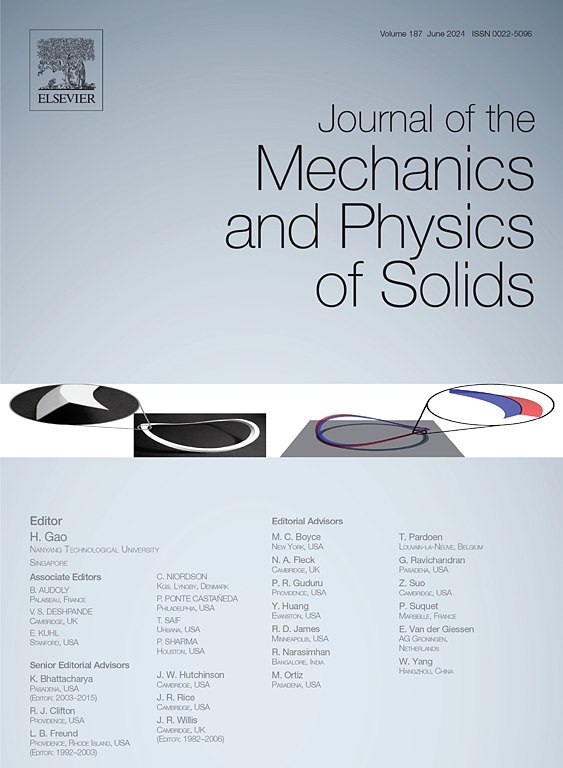A nonlinear model of shearable elastic rod from an origami-like microstructure displaying folding and faulting
IF 5
2区 工程技术
Q2 MATERIALS SCIENCE, MULTIDISCIPLINARY
引用次数: 0
Abstract
A new continuous model of shearable rod, subject to large elastic deformation, is derived from nonlinear homogenization of a one-dimensional periodic microstructured chain. As particular cases, the governing equations reduce to the Euler elastica and to the shearable elastica known as ‘Engesser’, that has been scarcely analysed so far. The microstructure that is homogenized is made up of elastic hinges and four-bar linkages, which may be realized in practice using origami joints. The equivalent continuous rod is governed by a Differential–Algebraic system of nonlinear Equations (DAE), containing an internal length ratio, and showing a surprisingly rich mechanical landscape, which involves a twin sequence of bifurcation loads, separated by a ‘transition’ mode. The latter occurs, for simply supported and cantilever rods in a ‘bookshelf-like’ mode and in a mode involving faulting (formation of a step in displacement), respectively. The postcritical response of the simply supported rod exhibits the emergence of folding, an infinite curvature occurring at a point of the rod axis, developing into a curvature jump at increasing load. Faulting and folding, excluded for both Euler and Reissner models and so far unknown in the rod theory, represent ‘signatures’ revealing the origami design of the microstructure. These two features are shown to be associated with bifurcations and, in particular folding, with a secondary bifurcation of the corresponding discrete chain when the number of elements is odd. Beside the intrinsic theoretical relevance to the field of structural mechanics, our results can be applied to various technological contexts involving highly compliant mechanisms, such as the achievement of objective trajectories with soft robot arms through folding and localized displacement of origami-inspired or multi-material mechanisms.

求助全文
约1分钟内获得全文
求助全文
来源期刊
CiteScore
9.80
自引率
9.40%
发文量
276
审稿时长
52 days
期刊介绍:
The aim of Journal of The Mechanics and Physics of Solids is to publish research of the highest quality and of lasting significance on the mechanics of solids. The scope is broad, from fundamental concepts in mechanics to the analysis of novel phenomena and applications. Solids are interpreted broadly to include both hard and soft materials as well as natural and synthetic structures. The approach can be theoretical, experimental or computational.This research activity sits within engineering science and the allied areas of applied mathematics, materials science, bio-mechanics, applied physics, and geophysics.
The Journal was founded in 1952 by Rodney Hill, who was its Editor-in-Chief until 1968. The topics of interest to the Journal evolve with developments in the subject but its basic ethos remains the same: to publish research of the highest quality relating to the mechanics of solids. Thus, emphasis is placed on the development of fundamental concepts of mechanics and novel applications of these concepts based on theoretical, experimental or computational approaches, drawing upon the various branches of engineering science and the allied areas within applied mathematics, materials science, structural engineering, applied physics, and geophysics.
The main purpose of the Journal is to foster scientific understanding of the processes of deformation and mechanical failure of all solid materials, both technological and natural, and the connections between these processes and their underlying physical mechanisms. In this sense, the content of the Journal should reflect the current state of the discipline in analysis, experimental observation, and numerical simulation. In the interest of achieving this goal, authors are encouraged to consider the significance of their contributions for the field of mechanics and the implications of their results, in addition to describing the details of their work.

 求助内容:
求助内容: 应助结果提醒方式:
应助结果提醒方式:


